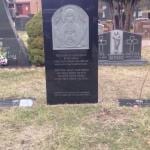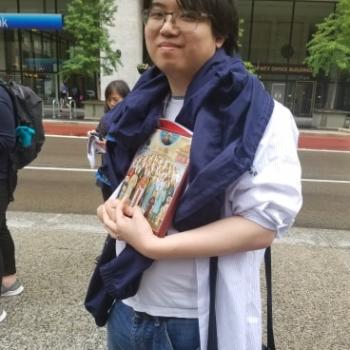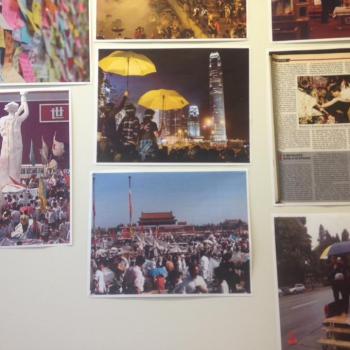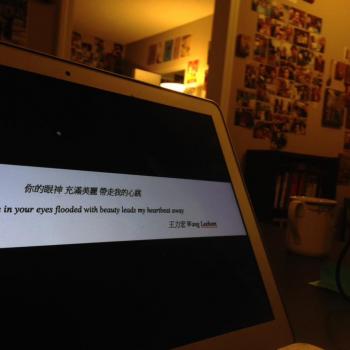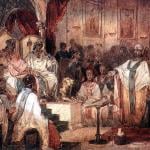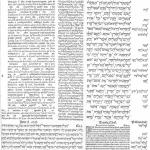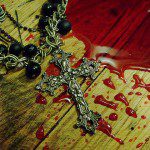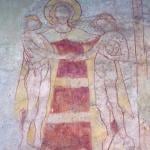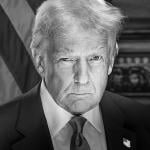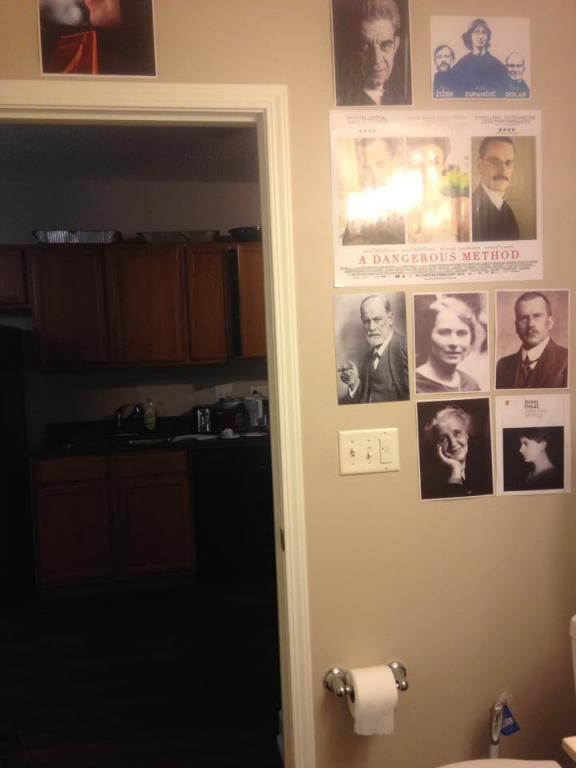
This post, written on the Sunday of Orthodoxy on the Old Calendar and of Gregory Palamas on the New, is occasioned by the death of Fr Myron Panchuk and his burial beneath a stone with the same inscription that sat above the doorway of the psychoanalyst Carl Jung’s home: Vocatus atque non vocatus deus aderit.
I have no idea what I think about Carl Jung. Please do not ask me about him. It’s like asking me about what I think about my parents. What did I ever do to you? Don’t do that to me. I’m really sensitive about it.
I can tell you, however, all my memories, dreams, and reflections concerning Jung over the years. When I first encountered him, I thought he was Chinese. I was still new to Catholic high school — everything in my life had been Protestant up to that point, including school — which is why I remained suspicious of my theology teacher, as theology signalled that we’d learn what the Catholic Church thought about things and not what the Bible said, which is what ‘Bible class’ used to be for at the Pentecostal school. What was more, this theology teacher had mastered the art of what I now called the dumb prof routine, the pretending to be an idiot in order to solicit more class discussion. I was not into it then, and now that I use it, I understand when my students roll their eyes. It’s just that it’s also a very effective teaching method.
Still, this theology teacher had a way of doing board work, which I have also stolen for my purposes. At the beginning of class, he’d write a word on the board — usually German, though I did not know it at the time. The first word to go up was HERMENEUTICS. We deliberated for what must have been an entire class session on what this word could possibly mean, after which he had someone read a Bible passage and give a makeshift interpretation. Then he said, Boys and girls, when you go home tonight, stand up at dinner and say, ‘Mom, Dad, I am a hermeneutician.’ I was fourteen — this was Freshman Theology in high school — and I did that when I got home. My dad, who was a pastor, told me to sit down.
The next day, he wrote WELTANSCHAUUNG, and again, we messed around for an entire class trying to figure out what on earth this word meant, and then he said something that I had heard in the land of evangelicalism: worldview. And then another day, he wrote MANDALA and said it wasn’t the South African guy (a joke that went over all of our heads), and then he proceeded to show us a bunch of circles with patterns on it via transparency slides. He showed us the book he had gotten it from, and then he wrote on the board JUNG. What’s Chung? someone said, and he retorted, Yung. That’s how I got the impression that Jung was Chinese, though I suppose there could have been the off-chance that he was Korean.
I soon learned about Freud too, but in English class, and I had no idea that Freud and Jung were connected, much less that they were frenemies. We did a reading regime in Freshman Honors English that went from Oedipus Rex to Joyce’s Dubliners to a documentary called The Ad and the Ego that featured cultural studies critics of the order of Sut Jhally, Jean Kilbourne, and Stuart Ewen. In this way, we learned about the Oedipus complex, the id, the ego, the superego, the phallus, and all the things, and from this curriculum, I inferred that quasi-Catholic secular people did literary analysis with their minds full of sex. Then, over in theology class, we’d do mandalas and weltanschauung in our hermeneutics, and I assumed that Catholics were all about big cosmic realities that could be seen in the Bible. To my great surprise, we actually read Genesis, during which the teacher wrote the word THEOPHANY on the board to indicate that our hermeneutic should take into account every time God reveals himself to the characters — and that somehow, this guy Jung was connected to it all too. In neither English nor theology class did anyone ever use the word psychoanalysis. We were just told to analyze, not summarize.
It was not until my high school senior year that I encountered Jung again on the curriculum. It was in a class on Christian spirituality, where the teacher introduced us to this online test called ‘Myers-Briggs.’ It wasn’t until later that I learned that those were the names of two people and that the letters ‘M’ and ‘B’ are not available for anyone’s MBTI personality profile. We did learn, however, that personality tests like the MBTI and the Enneagram were part of a broader, popularized Jungian agenda, and we understood that because in freshman theology three years before, the teacher had also written on the board ARCHETYPE. The profile that you get in these personality tests are basically snapshots of where you are in relation to archetypes that are said to represent major characters in cosmic consciousness. I scored an INFP, with my ‘N’ as way off the charts and ‘P’ as on the line with ‘J.’ Later on in life, I learned that I was closer to ‘INFJ,’ but with ‘J’ on the line with ‘P.’ I intuit from that that I am indecisive about making plans. I also made a mandala in that class. I stole the concept art from the Michael W. Smith Worship albums, the top as fire and the bottom as water, to indicate that though I was learning Catholic spirituality (which is what I thought Jung was), I was still evangelical, enjoying a direct relationship with God through the Spirit encountered both as fire and rain.
Of course, the Catholic high school theology curriculum is not the only place I encountered Jung. Jung is everywhere, even in evangelicalism. My dad was also doing a Doctor of Ministry at a conservative Baptist college at the time, and in a pastoral spirituality course, it was recommended, as a matter of standard practice in most institutions that offer courses on pastoral spirituality, that he read the trashy Gothic romance novels by the British novelist Susan Howatch known as the Church of England series. I still remember going with my dad to sit in on some of his classes. I was so bored at one of them that I read a trashy romance novel of my own choosing, Gone with the Wind (the book is better than the movie; the sequel is even more scandalous). But when I learned that my dad was reading trash romance, what had piqued my interest was that the Church of England series apparently described in some detail the sex lives of Anglican clergy, which made for a very interesting avenue for a fifteen-year-old boy warned by so many stories at church about why not to go to the grocery store to purchase plastic shrink-wrapped copies of Playboy (see this glorious graphic novel by Chester Brown for more information) to do some personal research about sex and how it could actually be fun, instead of, say, getting sex addiction, somebody pregnant, or an STI. And so it came to pass that one day, I found the book Scandalous Risks in my dad’s library, began reading it, had no idea who any of the characters were, and learned the hard way that I was reading the fourth novel in the series. I had done the same earlier in life with The Silver Chair, speaking of archetypes — it’s why it took me so long to get through that other Anglican book series called The Chronicles of Narnia, until a vaguely Taiwanese Buddhist friend saved me by lending me the first book — so I was not going to make the same mistake again.
Reluctantly, as the title Scandalous Risks seemed to promise to deliver on my interests, I put that one down and fumbled around the set until I learned which one was the first book, Glittering Images. It was the motherlode. The book begins with an exposition of Church of England power jockeying, which was unfamiliar to me because the only thing I knew about Anglicanism was that Henry VIII had divorced his wife and married Anne Boleyn, whom he beheaded, so it made sense to me (and later on, to the HBO series called The Tudors) that Howatch’s series was about sex. But the other thing was that, seen through the eyes of the conservative Anglican clergyman, everything was sexual, from Lyle the ‘ice queen’ he is investigating for her relationship to an older Anglican priest to some American woman named Loretta that he ends up having sex with in some outside location where there was bracken. I learned what an ‘hourglass figure’ was from those scenes; it meant, I discovered, that she had big boobs, and that was very important for me to know as a straight adolescent male.
Only later on in the book when the main character gets spiritual direction from a monk described as ‘Anglo-Catholic’ — I did not know that was a thing either — does Jung come up. As Glamorous Powers went through its dénouement into a crazy sex scandal involving Lyle the Ice Queen who actually turned out to be hot stuff and ends up with the conservative Anglican clergy dude and then went on into the next book, Glamorous Powers, to describe the sex life of the Anglo-Catholic spiritual director guy, it is suggested by the characters that Anglicanism really can be divided into the Jungian archetypes of ‘evangelical,’ ‘Anglo-Catholic,’ and ‘broad church.’ Not only are the books trashy, then, but their argument as a whole about Anglicanism, its clergy, and their sex lives is based on Jung. I never thought I’d actually ever become Anglican, much less a Chinglican, and much less have baggage with the whole thing after leaving it behind. I also never thought I’d finish the series, but later on, after I got off ordination track in the Anglican Communion, I did. The craziest thing, since I’m sure you won’t read it (spoiler alert, then), is that at the very end of the series, in the sixth book (each of them is like 500 pages), Lyle the Ice Queen dies, and the conservative Anglican guy ends up with Loretta with the big boobs. Of course, then Howatch couldn’t let the series go, so she started a series sequel where the first book is about a charismatic priest guy who also gets out of a marriage with an ice queen wife and shacks up with another woman with big boobs. I never finished that second series, as at that point, I started wondering whether the boobs were more Jung or Howatch. It’s like what Bernard says in Yes Prime Minister about trashy folks like me: Sun readers don’t care who runs the country as long as she’s got big tits. But that is the true story of my first intellectual encounter with the Anglican Communion: it was through Jung and jugs, and that was through my dad’s proverbial porn stash set of Susan Howatch novels.
My next serious encounter with Jung occurred when I was actually Anglican. There was an unserious one too, when my sister was in music school and had to play for an opera at the university’s music hall. Every so often, in atonal melodies, the performers who were pretending to be Jung’s patients would cry out, Carl Jung! Carl Jung! That was stuck in my head for more than a month.
But more seriously, I had, after accepting that I had become an Anglican, become friends with a Filipina nun, the one who saw the Blessed Virgin standing next to me. She had done graduate study in Rome and had written her thesis on the passage in the Apocalypse where the message from the Lord to one of the churches is that their name would be on a white stone. It was an account of identity and consciousness and heavily utilized Jung to talk about it. As she directed folks who came to her seeking advice about prayer, she’d help them think through their personalities through Jungian archetypes, with the help of the enneagram and Myers-Briggs, but never strictly through them. Personality tests are just snapshots, she said. One day you may be this, and the other you may be that, but the reason we do them is because we want to know how you are praying now, from what position you are currently approaching God.
This nun and I became very good friends. It can be said, in fact, that she helped me through the process of becoming a real human being so that I might become datable. But we lost touch, because she got transferred out of Vancouver, and I got married to a woman whose parents were deeply invested in Cantonese Protestant communities that were also obsessed with MBTI and enneagrams. Because of this, personality tests — and for me, Jung himself — became a source of mockery, though I never ever told anyone how I really got into Anglicanism and how I actually first encountered Catholic theology because I was Anglican at that time going up the liturgical ladder and could not be seen to be making fun of what I was becoming. Instead, I’d listen with a smirk on my face to aunties and uncles trying to figure out in Cantonese whether they were a 2, or 9, or a 6 on the enneagram. Later on, after I became Eastern Catholic, I told my Jesuit spiritual father about this experience, and he threw up his hands in dismay. I thought only the Jesuits were into that! he exclaimed, and these are evangelicals! What happened to the Bible? I responded with something to the effect that, when it comes to pop psychology, the evangelicals usually seem to lick the scraps from under the Catholics’ table.
From there, I went along my merry way mocking Jung. My favourite Jung thing at that point became A Dangerous Method , which I saw on a plane ride to Hong Kong and was gratified that Freud kept himself clean, but Jung had an affair (at least in the movie) with Sabina Spielrein, who is appropriately played by Keira Knightley. I did not realize that I’d actually become a fan of Spielrein’s because she articulates the death drive so much better than Freud, who stole it from her. At that point, the whole point of the movie was that Keira Knightley was in it. I don’t even remember who plays Jung. I just recall that Aragorn (or, a guy named Viggo) was Freud, and his counterpart, unlike Keira’s love interest in Pirates of the Caribbean, was not Legolas.
But then, I became Eastern Catholic, and soon after my chrismation, I moved from Richmond to Chicago, and then I fell in with Julian Hayda and Fr Myron Panchuk and the ‘growing number’ that became the Kyivan Psychoanalysis Study Group. One day while driving to church, Julian told me that Fr Tom Glynn, another priest in our church that he had respected (eternal memory), had been really into Carl Jung, and I began smirking until he said that his father, Fr Pavlo Hayda of blessed memory, had also been into Jung. What about Fr Myron? I asked, hoping that at least the guy who has a doctorate in depth psychology would know better. Alas, he was too, and it was confirmed at the cemetery shortly thereafter when I saw that the three of them were all to be buried, along with Julian’s mom a hundred years from now, under a stone with the same inscription that was over Jung’s house, Vocatus atque non vocatus deus aderit. Julian then pointed to the Slavonic translation under the Latin script and proudly told me that a prominent young liturgist in our church had done it for them. I resisted a facepalm. Instead, I said something inane about how Jung was central to my first encounters with Catholic theology and how it was all so full circle that now that I am Eastern Catholic that I’d have fallen in with the same crowd.
Jung came up a lot in our discussions as a group. Fr Myron told me to read Memories, Dreams, Reflections — or MDR, he said, winking at me before continuing, That’s what the professionals call it. I got through the first chapter, but it became apparent to me that the reason he wanted me to read Jung was to be able to locate him among the psychoanalysts. Freud may have begun to analyze the transference, Fr Myron would say over and over, but he was the one with the real mommy and daddy issues, as any time a man like Adler or Jung disagreed with him, they’d become dead to him, but every time a woman might want to say something different, like Spielrein or his daughter Anna Freud, he’d incorporate their work into his own. I discovered that he was right while reading Jung’s Psychology of the Transference. Jung tells a story of how he and Freud, on their first meeting, discussed every manner of thing pertaining to psychoanalysis, and then Freud suddenly asks him what he thinks of the transference, to which he says that it’s the ‘alpha and omega’ of the profession, to which Freud says to him that he has ‘grasped the main thing.’ The only problem is that Freud and Jung fell out because Jung disagreed with Freud. Freud thought that transferences were from individual experiences of childhood sexuality — a bit like how my English teacher taught Joyce’s Dubliners, with its scenes of childhood crushes, masturbation, and other intimations of sexual activity — but Jung connected them to archetypal cosmic realities.
Of all folks that I soon encountered after my conversations with Fr Myron, I then stumbled on a conversation between Camille Paglia and Jordan Peterson, where Paglia talks circles around Peterson and gets him to go along with everything says. We agree on everything, everything, she croons in triumph at the end. But what is more interesting is what they agree on, or at least wished they did. They both despise ‘postmodernism’ — or more precisely, French post-structural theory from philosophers whom they (meaning Paglia) accuse of theorizing from the student movements of 1968 without really being part of them. Paglia’s claim, which she makes as fabulously as only Paglia can, is that the betrayal of the protests was an intellectual one. The students, she argues, had been reading Jung, and the idea was that the world could be reformulated in terms that were more coherently humane instead of through the fragmentations wrought by inhuman technocratic structures. Peterson, of course, looks like a lost puppy through Paglia’s lecturette and interjects only with what he knows — the mother of all Jungian big boob books, Erich Neumann’s Great Mother, on which his Maps of Meaning is apparently largely based. Apropos of straight male desires that resemble my teenage curiosity about Howatch’s trashy Anglican series, Peterson launches into a whole tirade about maternal archetypes that are being erased by contemporary student activists. I was sufficiently intrigued by the conversation to get all these books, but while I was working through them, Peterson’s more unfortunate 12 Rules for Life came out, and on top of being a self-congratulatory self-help book, its reduction of psychoanalysis to biological features when he compares humans to lobsters signalled to me that he was way out of his philosophical depth. The whole point of psychoanalysis, after all, is that biology does not explain everything.
What I am saying is that I came away from that whole Jordan Peterson flash-in-the-pan of yesteryear being totally unconvinced of Peterson’s credibility on one hand and being tempted to give Jung a second chance on the other. On this temptation, I have received well the warning of my friend, the theologian Adam DeVille, especially in his own takedown of Peterson. DeVille is writing a book on Freud and theology, whereas I am just making use of psychoanalysis to save my own soul, so I’ve heard him loud and clear. He basically thinks Jung is dishonest, that the attempt to include the feminine in the divine is ‘specious,’ and that trying to use psychoanalysis to re-articulate Trinitarian theology is a non-starter. Better Freud’s atheism than Jung’s quasi-Christianity, he says, and I think Slavoj Žižek, who says that the only true atheism is through Christianity, would agree. I do want to see more of what Jung says on his own terms, though, especially because, love him or hate him, it seems like every Catholic intellectual who has ever had a hand in my theological formation has had some encounter with him.
That was pretty much where I was until last week. Then Fr Myron died.
These thoughts are actually all triggered by Fr Myron’s death because in writing about him and the origins of our Kyivan Psychoanalysis Study Group, the question that has constantly come up for me is: so what do I think of Jung? To me, this is an absolutely terrifying question. It’s not that I don’t know enough Jung, though I could of course read him more and finally finish MDR. It’s rather that it’s a referendum on my entire theological existence, on my conversion from Protestantism to Catholicism, which is terribly ironic because Jung’s family was Protestant and his own secularity was protestantizing. The question is laced in with my own development from adolescence to adulthood, in my own sexual maturation, in the integration of my erotic desires with the practices of my body, in the sexualized maternal objects of desire called boobs. It’s like asking what I think of my own parents, or what fetishes turn me on, or whether I had sex last night. I’m not going to tell you. It’s personal.
I also don’t know if Jung is compatible with Orthodoxy. Probably not, I can hear DeVille saying. I do know that, whether in the terms of the Sunday of Orthodoxy on the Old Calendar or of St Gregory Palamas on the New today, the way that Orthodox theology is supposed to be done is messy. The Triumph of Orthodoxy, we Orthodox Christians remind ourselves constantly, is not about how we are superior to everyone else, but because the veneration of icons has triumphed over iconoclasm. The point of St Gregory Palamas, my spiritual father pointed out in a brilliant homily today, is that, unlike his opponents who wanted to insist on getting to understand the knowledge of the transcendent God, he wanted to work things out from the messiness of frail human encounters with the divine in prayer. My encounters with Jung are a mess, and surely, there is something that Jung saw in images like mandalas that were, like icons, windows into the divine and the meaning of deep reality. I suppose that what I am saying is that, like it or not, Jung has shaped my understanding of theological practice, and the question makes me nervous, as if the police are knocking to ask whether how I grew up was by the book. Of course, DeVille is also not the police. Far from it. I think in fact DeVille’s disapproval of Jung and my inability to get away from him are entirely compatible: my problems with Jung are actually Freudian, with transferences that are personal and individual, not cosmological.
But then, I also have an observation. As I have been wrestling in the last few weeks with my acceptance that I am caught between the institutions of academia and church — which is to say that I have finally accepted that as much as both spheres are fundamentally about persons, they are also institutions that I have to work with and through — it has come to my attention that, really, my encounters with Jung began in Catholic school, but quickly made the transition to being mostly about my private life: girls, sex, fragile masculinity, and church. Jung is not any more respectable than Freud in the halls of the academy, though I am musing on the larger possibility that most serious academic debates over the last 150 years or so have been about psychoanalysis, but I don’t think anybody would be caught dead in academia trying to argue for cosmic realities to which our consciousness is naturally connected. Jungian psychology, from its banal popularization in personality tests and Peterson’s attempt to become a self-help guru to the more serious theological possibilities, seem relegated like the categories of religion and sex to the realm of the private in a world that is normatively secular.
Perhaps that is why I have been reticent to talk about what I think of Jung. It’s private, and that spatial differentiation gives me pause, because what I am really saying when I can’t answer the question of what I think about Jung is that I have no idea how that boundary between the public and the private got drawn when it comes to him. But it’s intriguing and a bit unsettling. I wonder if this feeling is the alienation that Fr Myron always spoke about as the source of personal productivity, and I am probably curious enough to incorporate this problematic into my intellectual work between church and school. It is, after all, a postsecular thought at the end of the day, troubling the secular and its privatizing tendencies while laying claims to what is public.

